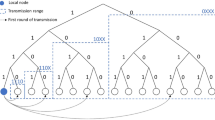Abstract
We propose a scalable blockchain P2P network transmission model. Using this model, data-transmitting nodes filter out the nodes that have received data according to the transmission path, thereby avoiding redundant forwarding. Furthermore, each K-bucket storing neighbor nodes is divided into multiple subareas, and neighbor nodes are evenly distributed to these subareas for reducing data-transmitting levels. Several redundant closer nodes transmit data to the target node for ensuring the target node receives the data. We analyzed the effective transmission rate, transmission efficiency and security of this model, and it shows that the performance of the data transmission improves.









Similar content being viewed by others
Explore related subjects
Discover the latest articles and news from researchers in related subjects, suggested using machine learning.Change history
27 August 2022
Affiliation has been Corrected.
References
Nakamoto S (2008) Bitcoin: a peer-to-peer electronic cash system. https://bitcoin.org/bitcoin.pdf
Ethereum White Paper (2015) A next-generation smart contract and decentralized application platform. https://github.com/ethereum/wiki/wiki/WhitePaper
Official Go implementation of the Ethereum protocol. https://github.com/ethereum/go-ethereum
Zhou T, Li X, Zhao H (2019) EverSSDI: blockchain-based framework for verification, authorisation and recovery of self-sovereign identity using smart contracts. Int J Comput Appl Technol 60(3):281–295
Zhao H, Li X, Zhan L et al (2015) Data integrity Protection method for microorganism sampling robots based on blockchain technology. Huazhong Univ Sci Technol 43(s1):216–219
Bitcoin Developer Guide (2009). https://bitcoin.org/en/developer-guide
DLeung D, Suhl A, Gilad Y et al (2019) Vault: fast bootstrapping for the Algorand Cryptocurrency. In: Network and distributed systems security (NDSS) symposium, 24–27 February 2019
A faster, more efficient cryptocurrency (2019). http://news.mit.edu/2019/vault-faster-more-efficient-cryptocurrency-0124
Corallo M (2016) Compact block relay. https://github.com/bitcoin/bips/blob/master/bip-0152.mediawiki
Clifford A, Rizun PR (2016) https://medium.com/@peter_r/towards-massive-on-chain-scaling-block-propagation-results-with-xthin-3512f3382276#.g50cw43hq
Higgins S (2016) Bitcoin’s ‘nervous system’ gets an upgrade with FIBRE network. https://www.coindesk.com/bitcoins-nervous-system-getting-upgrade
Bitcoin Unlimited. https://www.bitcoinunlimited.info/
Bitcoin cash—peer-to-peer electronic cash. https://www.bitcoincash.org/
Köhler E, Hilger M, Möhring RF et al (2006) Fast point-to-point shortest path computations with arc-flags. Dimacs implementation challenge: the shortest path problem
Wepiwe G, Simeonov PL (2005) A concentric multi-ring overlay for highly reliable P2P networks
Antonopoulos AM (2014) Mastering bitcoin. O’Reilly Media
P2P Network. https://developer.bitcoin.org/reference/p2p_networking.html
Wood G (2020) Etherenum: a secure decentralised generalised transaction ledger. https://ethereum.github.io/yellowpaper/paper.pdf
Katkuri S (2018) A survey of data transfer and storage techniques in prevalent cryptocurrencies and suggested improvements. https://arxiv.org/abs/1808.03380
EOS.IO Technical White Paper v2 (2018). https://github.com/EOSIO/Documentation/blob/master/TechnicalWhitePaper.md#eosio-technical-white-paper-v2
Bowe S, Gabizon A (2018) Making groth’s zk-snark simulation ex-tractable in the random oracle model. Cryptoly ePrint Archive, Report2018/187, 2018. https://eprint.iacr.org/2018/187
Meckler I, Shapiro E (2018) Coda: decentralized cryptocurrency at scale. https://codaprotocol.com/static/coda-whitepaper-05-10-2018-0.pdf
Ross KW Dan Rubenstein. P2P systems
Andy O (2003) Peer-to-peer: harnessing the power of disruptive technologies, O'Reilly & Associates
Ripeanu M et al Mapping the gnutella network: properties of large-scale peer-to-peer systems and implications for system design
Androulaki E, Barger A, Bortnikov V et al (2017) Hyperledger fabric: a distributed operating system for permissioned blockchains
Benet J (2014) IPFS—content addressed, versioned, P2P file system. http://ipfs.io
Loewenstern A, Norberg A (2017) DHT protocol. http://www.bittorrent.org/beps/bep_0005.html
Karp B, Ratnasamy S, Rhea S, Shenker S (2004) Spurring adoption of DHTs with OpenHash, a Public DHT Service, IPTPS
Wang L, Kangasharju J (2013) Measuring large-scale distributed systems: case of bittorrent mainline dht. In: 2013 IEEE thirteenth international conference on peer-to-peer computing (P2P), IEEE, pp 1–10
Stoica I, Morris R, Karger D et al (2001) Chord: a scalable peer-to-peer lookup service for internet applications. ACM SIGCOMM
Rowstron A, Druschel P (2001) Pastry: scalable, decentralized object location, and routing for large-scale peer-to-peer systems
Ratnasamy S, Francis P, Handley M et al (2002) A scalable content-addressable network. University of California, Berkeley
Maymounkov P, Mazieres D (2002) Kademlia: a peer-to-peer information system based on the XOR metric, IPTPS. http://www.cs.rice.edu/Conferences/IPTPS02/109.pdf
Bittorrent Sync (2014)
Blockmeta. The blockchain data of Bitcion. https://blockmeta.com/btc-stat
Ethereum (ETH) Blockchain Explorer. https://etherscan.io/
Ding D, Jiang X, Wang J et al (2019) Txilm: lossy block compression with salted short hashing. CoRR abs/1906.06500
Compact Blocks FAQ. https://bitcoincore.org/en/2016/06/07/compact-blocks-faq/
Acknowledgements
This work was partially supported by the National Natural Science Foundation of China (No. 61602435), Natural Science Foundation of Anhui Province (No. 1708085QF153).
Author information
Authors and Affiliations
Corresponding author
Additional information
Publisher’s Note
Springer Nature remains neutral with regard to jurisdictional claims in published maps and institutional affiliations.
Rights and permissions
Springer Nature or its licensor holds exclusive rights to this article under a publishing agreement with the author(s) or other rightsholder(s); author self-archiving of the accepted manuscript version of this article is solely governed by the terms of such publishing agreement and applicable law.
About this article
Cite this article
Yu, B., Li, X., Zhao, H. et al. A scalable blockchain network model with transmission paths and neighbor node subareas. Computing 104, 2253–2277 (2022). https://doi.org/10.1007/s00607-021-00913-1
Received:
Accepted:
Published:
Issue Date:
DOI: https://doi.org/10.1007/s00607-021-00913-1
Keywords
Mathematics Subject Classification
Profiles
- Bin Yu View author profile




